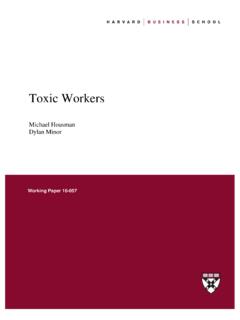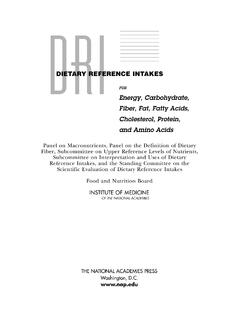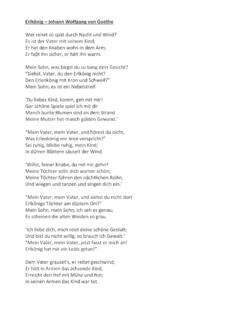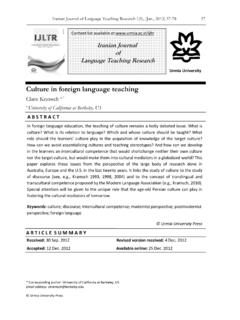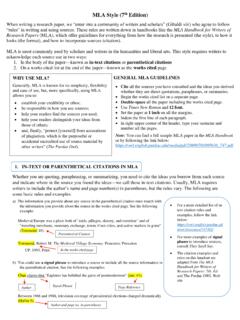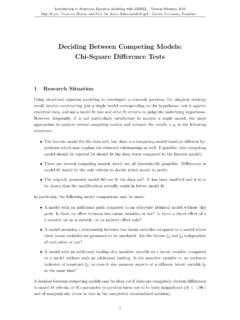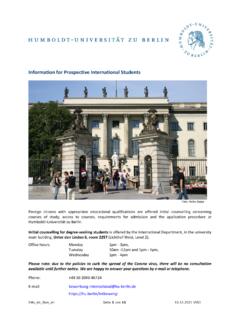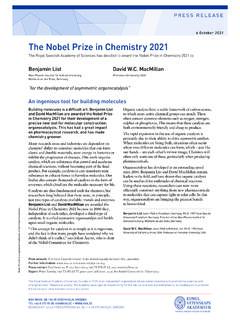Transcription of Equal or Value Weighting? Implications for Asset-Pricing Tests
1 Equal or Value Weighting? Implications for Asset-Pricing TestsApril 2014 Yuliya PlyakhaUniversity of LuxembourgRaman UppalEDHEC Business SchoolGrigory VilkovMannheim university and goethe university Frankfurt2 AbstractDoes the choice of weighting scheme used to form test portfolios influence inferences drawn from empirical Tests of asset pricing? To answer this question we first show that, with monthly rebalancing, an Equal -weighted portfolio outperforms a Value -weighted portfolio in terms of total mean return, four-factor alpha, and Sharpe ratio. We then explain that this outperformance is partly because the Equal -weighted portfolio has higher exposure to systematic risk factors; but, a considerable part (42%) of the outperformance comes from the difference in alphas, which is a consequence of the rebalancing to maintain constant weights in the Equal -weighted portfolio.
2 Finally, we demonstrate that the inferences drawn from Tests of Asset-Pricing models are substantially different depending on whether one uses Equal - or Value -weighted test portfolios. We illustrate this by considering four applications: (1) a test of the CAPM, using the methodology of Gibbons, Ross, and Shanken (1989); (2) a test of the spanning properties of the stochastic discount factor, using the approach of Hansen and Jagannathan (1991); (3) a test of the relation between characteristics and returns, using the multivariate weighted two-stage procedure of Fama and MacBeth (1973); and (4) a test of whether expected idiosyncratic volatility is priced or not, using the non-parametric methodology of Patton and Timmermann (2010). For all four Tests , we explain how the weighting scheme influences our : empirical asset pricing, factor models, systematic risk, alpha, idiosyncratic.
3 G11, G12We gratefully acknowledge comments from Elena Asparouhova, Turan Bali, Hank Bessembinder, Michael Brennan, Oliver Boguth, Ian Cooper, Victor DeMiguel, Engelbert Dockner, Bernard Dumas, Nikolae G rleanu, Will Goetzman, Amit Goyal, Antti Ilmanen, Ivalina Kalcheva, Philipp Kaufmann, Ralph Koijen, Lionel Martellini, Stefan Nagel, Stavros Panageas, Andrew Patton, David Rakowski, Tarun Ramadorai, Paulo Rodrigues, Bernd Scherer, Norman Seeger, Eric Shirbini, Mungo Wilson, Michael Wolf, Josef Zechner, and participants of seminars at the EDHEC-Risk Days Europe Conference, Endowment Asset Management Conference at the university of Vienna, European Summer Symposium in Financial Markets at Gerzensee, Edhec Business School (Singapore), goethe university Frankfurt, Multinational Finance Society Conference (Krakow), Norges Bank Investment Management, S&P Indices, university of Innsbruck, and university of Southern is one of the top five business schools in France.
4 Its reputation is built on the high quality of its faculty and the privileged relationship with professionals that the school has cultivated since its establishment in 1906. EDHEC Business School has decided to draw on its extensive knowledge of the professional environment and has therefore focused its research on themes that satisfy the needs of pursues an active research policy in the field of finance. EDHEC-Risk Institute carries out numerous research programmes in the areas of asset allocation and risk management in both the traditional and alternative investment 2014 EDHEC31 - Equal -weighted mean returns are used in a large number of papers on empirical asset pricing (see, for example, the classical work of Fama and MacBeth (1973), Black, Jensen, and Scholes (1972), and Gibbons, Ross, and Shanken (1989)), almost all event-studies, and the research that relates mean returns to firm characteristics (for reviews of this literature, see Campbell, Lo, and MacKinlay (1997) and Kothari and Warner (2006)).
5 Asparouhova, Bessembinder, and Kalcheva (2013, p. 666) write: For example, examining papers published in only two premier outlets, The Journal of Finance and The Journal of Financial Economics, over a recent 5-year (2005 to 2009) interval, we are able to identify 24 papers that report EW mean returns and compare them across portfolios. 2 - We consider the price-weighted portfolio for robustness even though it is used only occasionally as an index (for example, the Nikkei index, or the Dow Jones 30 Index), and almost never for Asset-Pricing - DeMiguel, Garlappi, and Uppal (2009) show that the performance of the Equal -weighted portfolio is no worse than that of portfolios based on mean-variance optimisation, such as Markowitz (1952) and its extensions, because of the error in estimating parameters used by the optimising portfolios; Jacobs, Muller, and Weber (forthcoming) extend this finding to other datasets and asset classes.
6 However, DeMiguel, Garlappi, and Uppal (2009) do not explain how the Equal -weighted portfolio would perform relative to Value - and price-weighted portfolios. Given that Equal -, Value -, and price-weighted portfolios do not rely on estimated parameters, it is not clear that one will perform better than the others. In fact, the CAPM suggests that the Value -weighted portfolio should outperform the Equal - and price-weighted - Including the reversal factor in addition to the four factors reduces the alpha of the Equal -weighted portfolio by 11%, but does not affect the alphas of the Value - and price-weighted - For the literature on momentum and contrarian strategies, see Jegadeesh (1990), Conrad and Kaul (1998), Jegadeesh and Titman (1993, 2002), Lo and MacKinlay (1990), DeMiguel, Nogales, and Uppal (2013), and Asness, Moskowitz, and Pedersen (2009).
7 6 - We check the robustness of these results along a variety of dimensions. When selecting a sample of stocks from the S&P 500 index, we don t consider just one portfolio with 100 stocks, but we resample to select 1,000 portfolios, and all the results we report are based on the performance metrics averaged across these 1,000 portfolios. In addition to the results reported for portfolios with 100 stocks, we consider portfolios with 30, 50, 200, and 300 stocks (again, with resampling over 1,000 portfolios). Besides the stocks sampled from the S&P 500 for large-cap stocks, we also consider stocks from the S&P 400 for mid-cap stocks and the S&P 600 for small-cap stocks. We also test the sensitivity of our results to different time periods and economic conditions: we study the performance of the Equal -weighted portfolio relative to the Value - and price-weighted portfolios if one had invested in the strategy at the peak of the business cycle (March 2001 or December 2007) or the trough (November 2001).
8 Finally, we use four methods to correct for potential biases arising from noisy prices and liquidity differences across stocks, as suggested in Blume and Stambaugh (1983), Asparouhova, Bessembinder, and Kalcheva (2010, 2013), and Fisher, Weaver, and Webb (2010). We find that our results are robust to all these variations, and therefore, our findings about the differences in the returns of Equal - and Value -weightedportfolios are complementary to IntroductionOn the one hand, the Value -weighted market portfolio has played a central role in asset pricing, for instance in the Capital Asset Pricing Model of Sharpe (1964), On the other hand, the use of Equal -weighted mean returns is ubiquitous in empirical Does the choice between Equal - and Value -weighting impact inferences when testing Asset-Pricing models? Our main contribution is to answer this question, which we do in three steps.
9 First, we show that there is a substantial difference in the performance of Equal - and Value -weighted portfolios. Second, we identify the source of this difference in performance. Finally, we demonstrate that, because of this difference in performance, the inferences drawn from Tests of asset pricing models are substantially different, depending on whether one performs these Tests on Equal -or Value -weighted test assets. Below, we explain these three steps in greater detail, and relate them to the existing the performance of the Equal - and Value -weighted portfolios, and also the performanceof price-weighted portfolios,2 we show in the first step of our analysis that with monthly rebalancing the Equal -weighted portfolio outperforms Value - and price-weighted portfolios in terms of total mean return and one- and four-factor alphas, even after allowing for transaction costs of fifty basis The Equal -weighted portfolio, however, has a significantly higher volatility and kurtosis compared to the Value - and price-weighted portfolios.
10 Despite the unfavourable volatility and kurtosis, the Sharpe ratio and certainty-equivalent return of the Equal -weighted portfolio are higher than those of the Value - and price-weighted the second step of our analysis, in order to identify the reasons for this difference in performance, we construct Equal -, Value -, and price-weighted portfolios from stocks randomly selected from the constituents of the S&P 500 index over the last forty years. We use the standard four-factor model (Fama and French (1993) and Carhart (1997)) to decompose the total returns of these portfolios into a systematic component, which is related to factor exposure, and alpha, which is unrelated to factor exposure. We find that of the total excess mean return earned by the Equal -weighted portfolio over the Value -weighted portfolio, 58% comes from the systematic component, including compensation for exposure to smaller stocks, as one may have expected; however, 42% comes from the difference in alphas.

